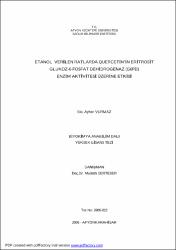Etanol Verilen Ratlarda Quercetinin Eritrosit Glukoz-6-fosfat Dehidrogenaz (G6PD) Enzim Aktivitesi Üzerine Etkisi
Özet
Alkolün vücut üzerindeki toksik etkileri bilinmektedir. Biz çalışmamızda alkolün
eritrosit Glukoz-6-fosfat dehidrogenaz (G6PD) enzim aktivitesi üzerine olan
etkilerini ve bu etkilerin ortadan kaldırılmasında antioksidan flavonoid ailesinin bir
üyesi olan quercetini kullanarak, eritrosit G6PD enzim aktivitesi üzerindeki
koruyucu etkisini ortaya koymaya çalıştık. Bilindiği gibi alkol metabolizması
sırasında reaktif oksijen ürünleri (ROS)’un oluşumu indüklenmekte ve bu zararlı
ajanlar nükleusu ve mitokondrisi olmayan eritrositlere zarar vermektedir. Pentoz
fosfat yolunun oksidatif basamağının kilit enzimi olan G6PD tarafından üretilen
NADPH’lar zararlı ajanların detoksifikasyonu sırasında oluşan okside glutatyonun
tekrar kullanılabilmesi için indirgenmesi sırasında kullanılmaktadır. Yeterli miktarda
NADPH sağlanamadığı takdirde ise okside glutatyon indirgenememekte ve buna
bağlı olarak hücre membran bütünlüğü korunamadığı için hemoliz oluşmaktadır.
Quercetin ise membran bütünlüğünün korunması ile ilgili rolü, ROS’un oluşturduğu
lipit peroksidasyonunu engellemeleridir. Bu amaçla 25 adet, 3-3,5 aylık 280-320 g
Sprague-Dawley erkek rat kullanıldı. Ratlar dört gruba ayrıldı: 1. Kontrol grubu
(K) (n=6): Bu gruba 30 gün süre ile intra gastrik (i.g.) yolla 2 ml/gün serum
fizyolojik (SF) verilmiştir. 2. Quercetin Grubu (Q) (n=7): 30 gün süre ile 3 günde 1
kez 100 mg/kg quercetin ve 1 ml SF verildi. Quercetin, % 3 g olarak SF ile süspanse
edilerek hazırlanmıştır. 3. Alkol Grubu (EtOH) (n=7): 30 gün süre ile i.g. olarak,
12 saat açlıktan sonra etanol (EtOH) verilmiştir. Distile su ile hazırlanan %80 EtOH
(v/v) 1 ml/gün ve SF 1 ml/gün olarak verilmiştir. EtOH verildikten bir saat sonra ise
yem ve su verilmiştir. 4. Quercetin + Alkol Grubu (Q+EtOH) (n=5): 30 gün
boyunca i. g. Olarak 3 günde 1 kez 100 mg/kg quercetin verildikten 2 saat sonra %
80 (v/v) EtOH'den 1 ml/gün verilmiştir. EtOH verildikten bir saat sonra yem ve su
verilmiştir. Lityum+heparinli tüplere alınan kan numunelerinden eritrositlerde G6PD
enzim aktivitesi Modified-Zinkham metoduna göre ölçülmüştür. Çalışma sonucunda
quercetin grubunda G6PD enzim aktivitesi alkol grubuna göre anlamlı olarak yüksek
bulundu (6,38 ± 0,4 IU/gHb ve 3,82 ± 0,67 IU/gHb, p<0,001). Alkol grubunda G6PD
enzim aktivitesi kontrol grubuna göre anlamlı olarak düşük bulundu ( 3,82 ± 0,67
IU/gHb ve 6,03 ± 0,4 IU/gHb, p<0,001). Kontrol ile quercetin +alkol grubu arasında
G6PD enzim aktivitelerinde anlamlı bir fark bulunamamıştır (p=0,384), Quercetin ile
kontrol grubu arasında anlamlı bir fark yoktur (p=0,704). Alkol grubu ile quercetin +
alkol grubu arasında istatiksel olarak anlamlı bir farklılık görülmüştür ( 3,82 ± 0,67
IU/gHb ve 5,46 ± 0,78 IU/gHb, p<0,001).
Bu sonuçlar, alkolün eritrosit G6PD enzim aktivitesini azaltan etkisinin
olduğunu ve quercetinin bu etkiyi engellemede başarılı olduğunu göstermiştir. The toxic effects of ethanol on human body are well known. In this study, we aimed
to evaluate the effects of ethanol on erythrocyte (G-6-P-D) enzyme activity and the
effects of quercetin, a number of antioxidant flavonoids on erythrocyte G-6-P-D
activity in the recovery of the effects of ethanol. It’s well known that, during ethanol
metabolism, the formation of reactive oxygen species (ROS) is induced and these
agents damage the erythrocytes which are lack as nucleus and mitochondria.
G-6-P-D catalyzes the key step in penthose phosphate pathway, during which
NADPH molecules are produceds. NADPH is used to reduce the oxidized
glutathione formed during detoxification reactions. In case of NADPH depletion,
hemolysis occurs as a result of lass of membrane integrity by inhibiting the ROSinduced
lipid peroxidation.
In this study, 25 male Sprague-Dawley rats weighing 280-320 g (3-3,5
months) were assiggned into one of the four groups. The rats were on Standard diet
and drink water ad libitum. 12 h of light and dark aycles were performed and the
environmental temperature was kept between 25-28 0C. The control group (n = 6)
received saline i. g (2 ml/day). The quercetin group (n = 7) received quercetin once
upon days 100 mg/ kg via i.g. and saline (1 ml/day) coute for 30 days. The Alcohol
Group (n = 7) received ethanol ( %80 v/v, 1 ml/ day) via i. g. and saline (1 lm/day)
Coute for 30 days. The Alcohol + Quercetin Group ( n = 5) received 1 ml of
Ethanol ( %80 v/v) 2 hours after quercetin treatment once upon days 100 mg/ kg
for 30 days.
The blood was drawn on Lithium heparine coutaining tubes. After erythrocyte
package was prepared, erythrocyte G-6-P-D activity was measured according to
modified Zinkham Method. G-6-P-D activity was found to be higher in the Quercetin
Group than those in the Alcohol Group ( 6,38 ± 0,4 IU/gHb vs 3,82 ± 0,67 IU/gHb,
p<0,001). In the Alcohol Group, the erythrocyte G-6-P-D activity was found to be
significantly decreased than those in the Control Group ( 3,82 ± 0,67 IU/gHb vs 6,03
± 0,4 IU/gHb, p<0,001). No statistically significant differences were found between
the Control Group and the Alcohol + Quercetin Group. Moreover, statistically
significant differences were observed in erythrocyte G-6-P-D activity between the
Alcohol Group and the Alcohol + Quercetin Group ( 3,82 ± 0,67 IU/gHb ve 5,46 ±
0,78 IU/gHb, p<0,001).
As a couclusion, our results demonstrate that ethanol decrease, erythrocyte
G6PD activity and quercetin was found to be beneficial in the prevetion of toxic
effect raised by ethanol.
Bağlantı
http://hdl.handle.net/11630/3943Koleksiyonlar
- Yüksek Lisans Tezleri [635]



















